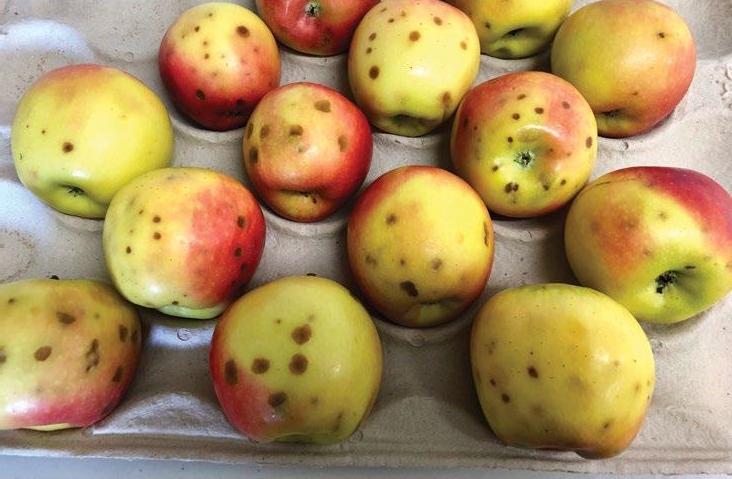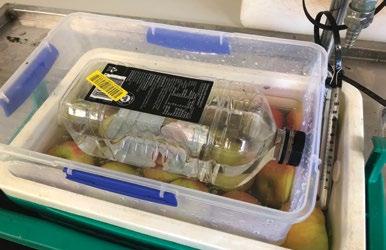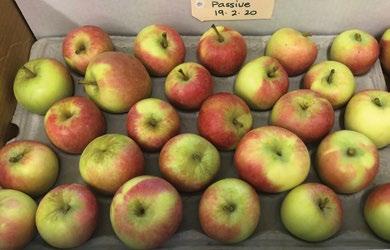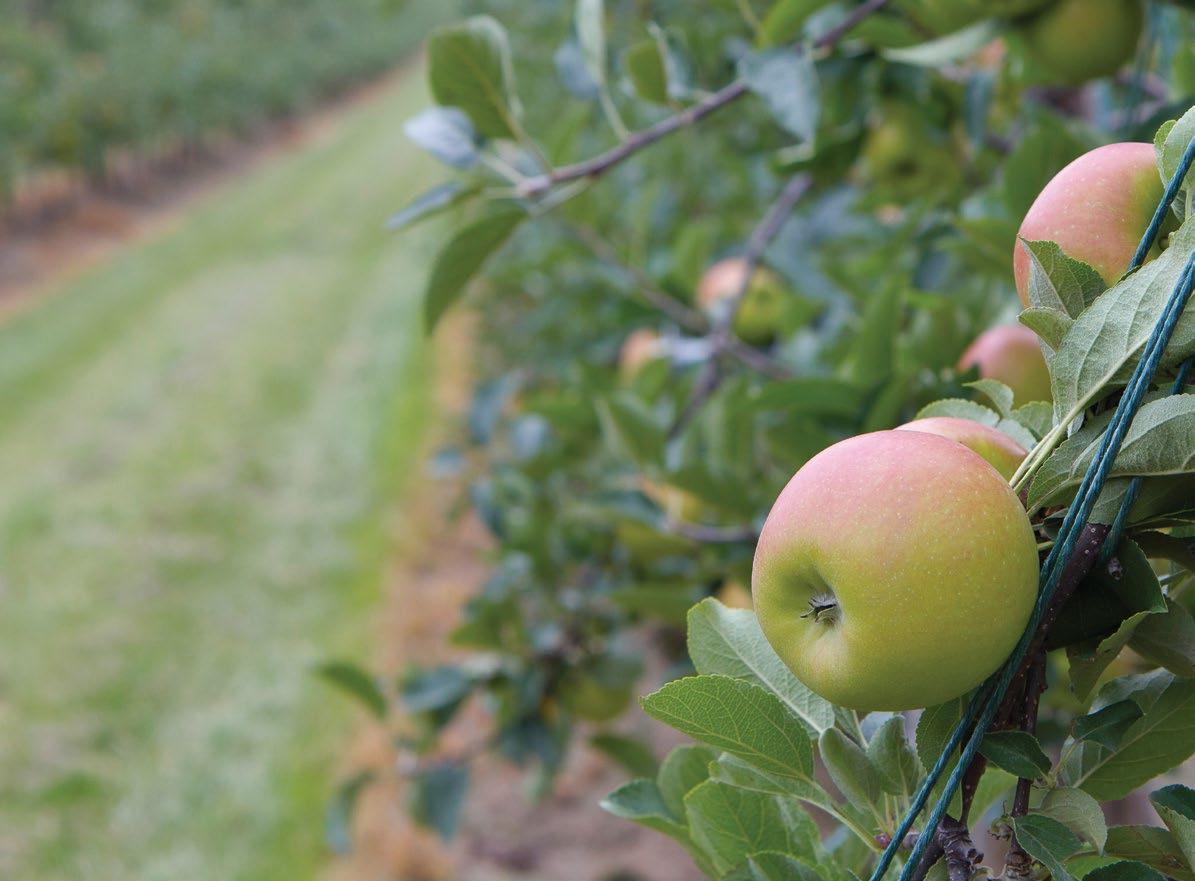
7 minute read
Predicting lenticel damage
in Kanzi ® apples
BY SUSIE MURPHY WHITE PROJECT MANAGER, POMEWEST
Advertisement
Testing methods highlighted the potential for lenticel damage in Kanzi ® apples in the 2020 season.
In the 2019 season Manjimup Kanzi ® apple growers reported a high percentage of lenticel damage to Kanzi ® apples that had come out of cool store. As the apples passed over the pre-sizer in mid-April 2019 the lenticel damage was high averaging about 7 per cent then spiking up to 50 per cent of the apples showing damage later in the season. Lenticel breakdown symptoms are expressed after post-harvest handling, but damage is initiated pre-harvest
when fruit are growing rapidly and the damage can be linked to low fruit calcium status. The damage can be mitigated by managing nutritional imbalances, crop load and excessive tree vigour.
Furthermore, moisture stress and excessive irrigation can also raise the incidence of lenticel damage. An observation trial was set up in March 2020 to investigate if lenticel damage can be predicted before harvest, therefore influencing which fruit is suitable for cool storage and which fruit is sold first. These treatments had been successfully used by Washington State University on Honeycrisp in 2017.
A trial was set up during March to investigate if lenticel damage can bepredicted.
Treatment methods 1 Hot water
An Esky was filled with hot water (49°C). The apples were submerged in the hot water and held under water for 30 minutes.
2

Ethephon
A plastic box was filled with 8L of water (24ºC) and 15ml of Ethephon was mixed into the water. Every apple was dipped (2 sec) in the prepared solution.
3

Passive
Fruit were placed on trays and kept at room temperature (±22°C).
3 LENTICEL damage in Kanzi ® apples in 2019

Samples of apples were taken from three orchards, two orchards experienced damage in 2019 and one orchard had no damage in 2019. Samples were collected three weeks prior to the expected harvest date. After the apples were treated, they were placed into trays and stored at room temperature for three weeks. The fruit were evaluated weekly until twenty-one days after treatment.
Treatment results
Orchard 1 showed greatest amount of damage rising to 13 per cent at day 21 for the Ethephon method (see Figure 1), 7 per cent for the passive method and 3 per cent damage for the hot water 16 14 12 2 0 ORCHARD 1
Calcium is drawn away from fruitlets to the shoot tips in vigoroustrees.
treatment. The apples treated with Ethephon; damage began to occur at 15 days after treatment.
All orchards responded to the Ethephon method with Orchard 2 and 3 showing 3 per cent of the apples damaged.
When the Kanzi ® apples came out of cool store for the 2020 season, the percentage of damage after 3 weeks was Orchard 1 had 14 per cent of apples with lenticel damage, Orchard 2 10 per cent and Orchard 3 had 3 per cent of apples. All methods showed a response and
10
8
6
4
Hot water Ethephon Passive
store Cool Hot water Ethephon Passive
ORCHARD 2
Cool store Hot water Ethephon Passive
ORCHARD 3
Cool store
FIGURE 1.
PERCENTAGE OF DAMAGED KANZI ® APPLES 21 DAYS AFTER TREATMENTS.

were able to predict that there would
be some damage to the fruit coming out of cool store. But the Ethephon had a more marked effect. When you look at the cool store pack outs and the results from the treatments the Ethephon method follows what actually happened with the apples coming out of cool store.
Nutrient uptake test
Nutrient uptake tests were undertaken on the Kanzi ® apple fruit and shoots at the time of sampling. To show nutritional balance at the time of sampling. In the fruit of Orchard 1 and 2 below detectable limit of nitrates were recorded. Orchard 2 had the highest calcium in the fruit sample, the highest potassium, ammonium, magnesium and phosphorous levels were in Orchard 3. The nutrient uptake in the shoots showed that Orchard 1 had very high manganese, high chloride, iron, zinc, magnesium and calcium. Whereas Orchard 2 and 3 were in the optimum range.
Nutrition and lenticel damage
Lenticel damage is caused by several factors which accumulate over time, and this trial has shed light on how nutrient imbalances contribute. Unbalanced nutrition, specifically low fruit calcium levels, are associated with the occurrence of lenticel damage. More specifically, high potassium and magnesium supplies promote lenticel damage because they directly lower the fruit calcium levels. This is because calcium is a cation and competes with potassium and magnesium (also both cations) in the fruit. Thus, the incidence of lenticel damage can be predicted from the fruit’s potassium, magnesium and calcium ratio (Table 1). Because orchards 1 and 3 had high potassium, magnesium and calcium ratio, unsurprisingly, they experienced lenticel damage. Furthermore, because Orchard 1 had the lowest amount of fruit calcium (Table 1), it also expressed the highest rates of lenticel damage. Similar to how calcium directly competes with potassium and magnesium, it can’t exist alone in the fruit without the appropriate amount of negatively charged anions like nitrate. Therefore, the below detectable levels (BDL) of nitrates in the fruit of Orchard 1 and 2 likely reduced the amount of calcium partitioned from the shoots (Table 2) to the fruit (Table 1).
An intensive calcium spray programme is critical to reduce instances of lenticel damage.
TABLE 1. APPLE FRUIT NUTRIENT UPTAKE (PPM).
Nutrient Upper Limit
Ca Mg K NO 3
BDL: Detectable levels 125 75 1750 50 Orchard 1
80 41 1123 BDL ^ Orchard 2
97 49 1115 BDL ^
TABLE 2. NUTRIENT UPTAKE OF SHOOT-TIP SAMPLES (PPM).
Nutrient
K Ca Mg NO 3 Upper limit 4500 700 1000 35 Orchard 1 4342 959 1312 20 Orchard 2 3763 629 1127 15 Orchard 3 85 56 1293 8.05

Lower limit 70 40 1000 10
Orchard 3 4350 623 1279 11 Lower limit 2750 300 500 10
3 MANAGING fruit potassium levels can be an essential procedure in reducing lenticel damage because elevated potassium status represents a high risk.
Orchard 1 had more expression of lenticel damage after Ethephon treatment at 13 per cent. There could be several reasons for this, however, the exact reason is beyond the scope of this trial. What we do know is that Orchard 1 also had higher shoot tip calcium levels than the other orchards (Table 2). We know calcium can be drawn away from the fruitlets to the shoot tips in vigorous trees, and this may explain the higher calcium level. Another reason may be that more calcium was applied however, higher calcium is often associated with lower lenticel damage but only if the calcium is in the fruit.
Lenticel damage risk mitigation
Results show that each method was successful at predicting lenticel damage in Kanzi ® apples. The percentages of apples expressing lenticel damage out of cool store proves that these methods do work for Kanzi ® apples. Ultimately all three orchards experienced lenticel damage due to unbalanced nutrition in the fruit. Lenticel damage risk mitigation mainly comes down to good pre- and postharvest horticultural practices. An intensive calcium spray programme over the growing season is critical to reduce instances of lenticel damage, and we recommend that growers work closely with their consultants, or spray representative, to design a programme that is appropriate to their blocks.
Managing fruit potassium levels can also be an essential procedure in reducing lenticel damage because elevated potassium status represents a high risk. Maintaining nutritional balance, optimum crop load and balanced tree vigour can all assist in reducing the potential of lenticel problems later in storage. Lastly, water availability can influence the occurrence of lenticel damage, not only can hot and dry conditions increase the rate of its occurrence, but excessive irrigation can do the same. Subsequently, due to the hot and dry 2019/2020 season, we expect that there will be more instances of lenticel damage compared to the 2018/2019 season. Growers can help minimise calcium export from the fruit, therefore reducing the risk of lenticel damage, by implementing a good irrigation strategy and minimising water stress during periods of high temperatures. There may be other reasons that explain the differences between orchards and treatments. What was interesting here is that the testing methods highlighted the potential for lenticel damage this season.
MORE INFORMATION
Susie Murphy White Pomewest Manjimup
susan.murphy-white@dpird.wa.gov.au
ACKNOWLEDGEMENT
This is a combined Pomewest and Future Orchards Trial implemented with support from Steve Spark AgFirst NZ. Thank you to the growers who have supplied fruit.










